‘BBC Breakfast’ gets rousing new studio, graphics updates
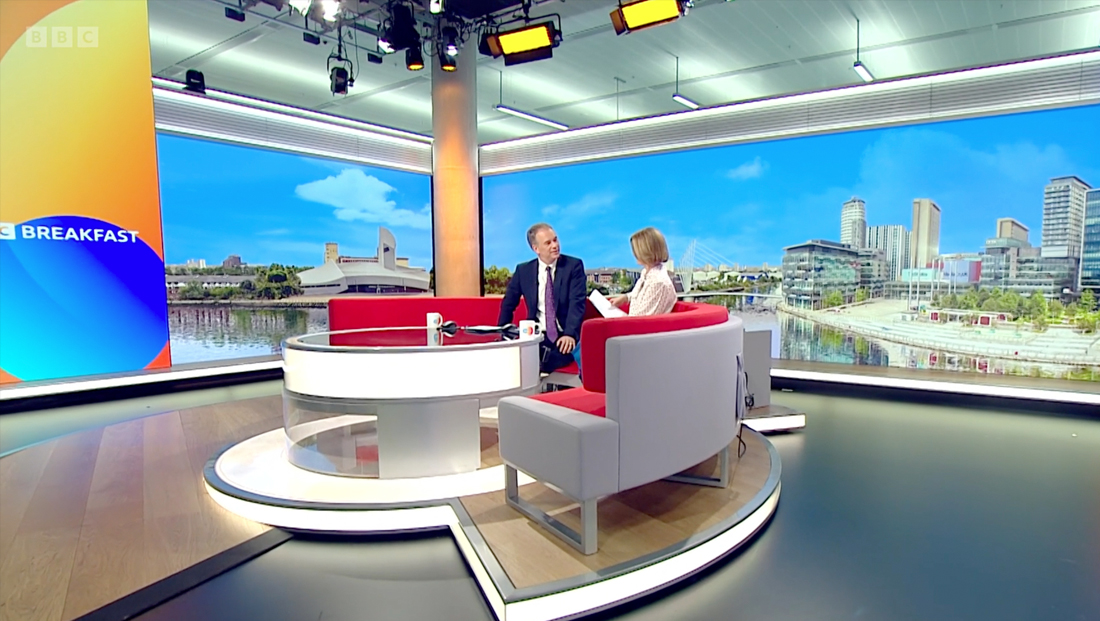
Weekly insights on the technology, production and business decisions shaping media and broadcast. Free to access. Independent coverage. Unsubscribe anytime.
“BBC Breakfast” has debuted an updated on-air look that better aligns the broadcast with the updated Studio B in London, its rollout of regional sets across the U.K. and several years’ worth of graphics changes at the broadcaster.
Starting in late June 2023, “Breakfast” moved onto a new set from Jago Design that it shares with select sports broadcasts.
The space adds signature elements from the current BBC design language, including large vertical video walls, curved displays, simulated exterior views with less interruption and the use of on-set graphics to enhance storytelling and visuals.
Graphics, meanwhile, have been given an update to align more with the flatter looks the broadcaster has been migrating toward.
Since 2012, “Breakfast” has broadcast from MediaCityUK in Salford, Greater Manchester, sharing a facility with the broadcaster’s sports division.
This new studio sits in the footprint of a circular, glassed-in studio originally dedicated to BBC Sport, branded as the “BBC Sports Centre,” which has also been used by “Breakfast” during Olympics coverage.
Previously, the morning newscast aired from an enclosed studio with one of the network’s signature curved sofas set in front of a wall of video screen windows and color-changing integrated lighting.
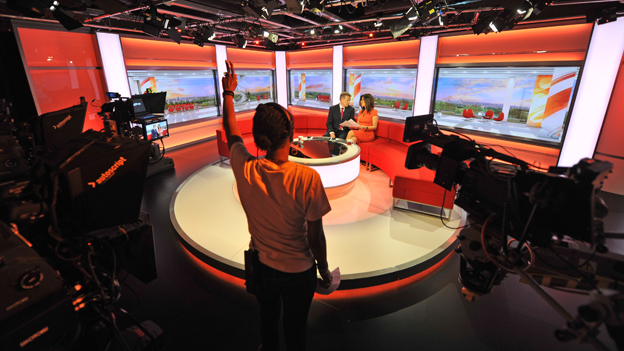

The old ‘BBC Breakfast’ studio and set, which was used for most broadcasts of the show prior to 2023. Image courtesy BBC.
The new studio, in contrast, has a physical connection with the open workspace beyond, both through its location and use of a large set of transparent panels that create a sort of glass-box-like space.
Inside the studio sits a new interpretation of the curved red sofa on the old set — one that’s similar to those found in Studio B and various regional facilities. Like those spaces, instead of the primarily red design, the unit now has a red seat and back cushions but with a light gray underlying support structure.
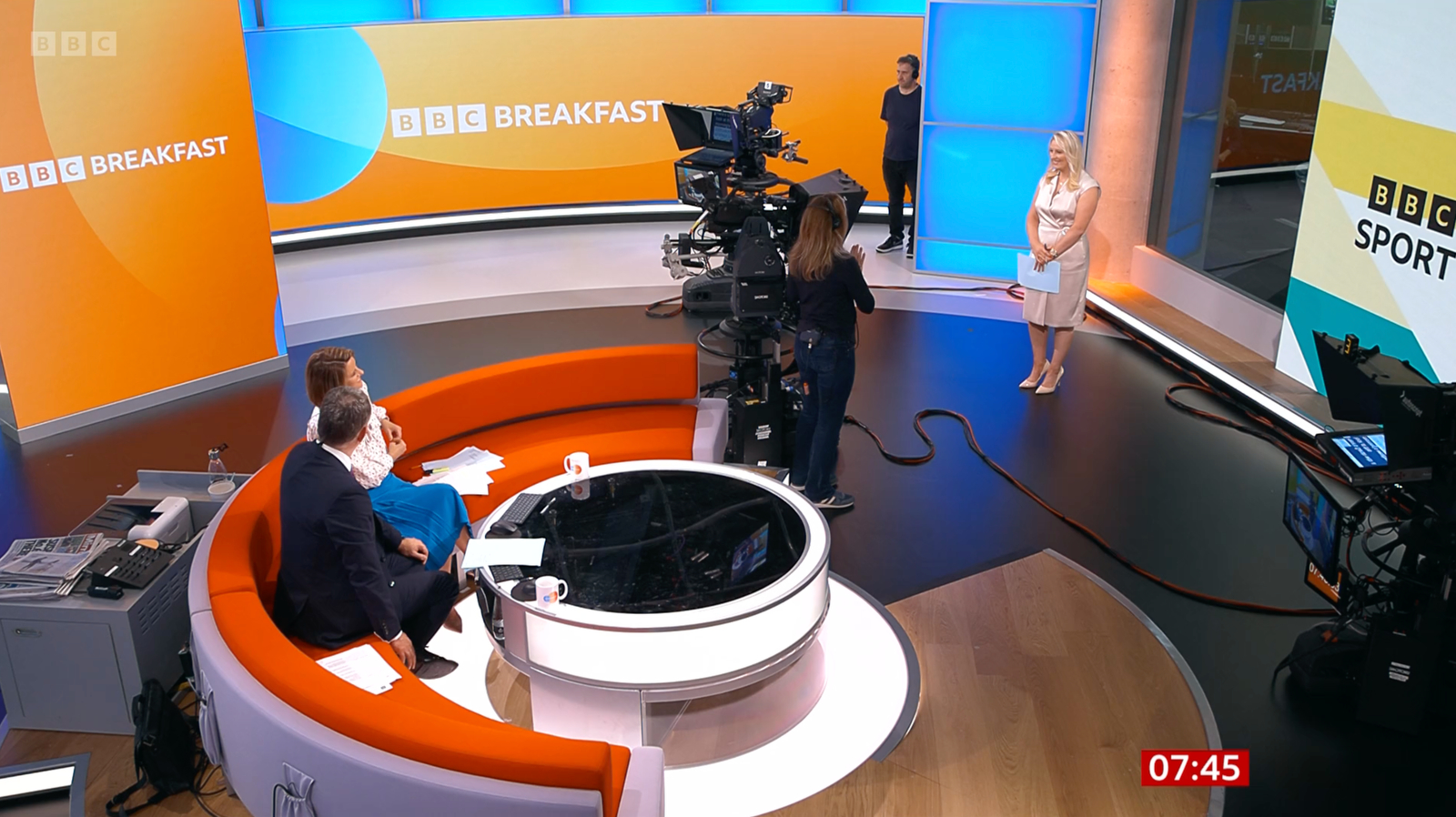

There is also an updated circular coffee table in front of the sofa and the entire sofa-area setup can rotate via a built-in mechanism, with the cushions also swappable to gray versions for sports broadcasts.
The new “Breakfast” studio has multiple nods to the LED towers found on other BBC broadcast spaces, though two of them are integrated directly into the wall that divides the studio and workspaces beyond.
Those towers can be used as either standup locations or, when the sofa is rotated, to display OTS-style graphics behind presenters seated at the sofa. The final tower is set at an angle and helps create the feel of two distinct spaces with the same open studio.
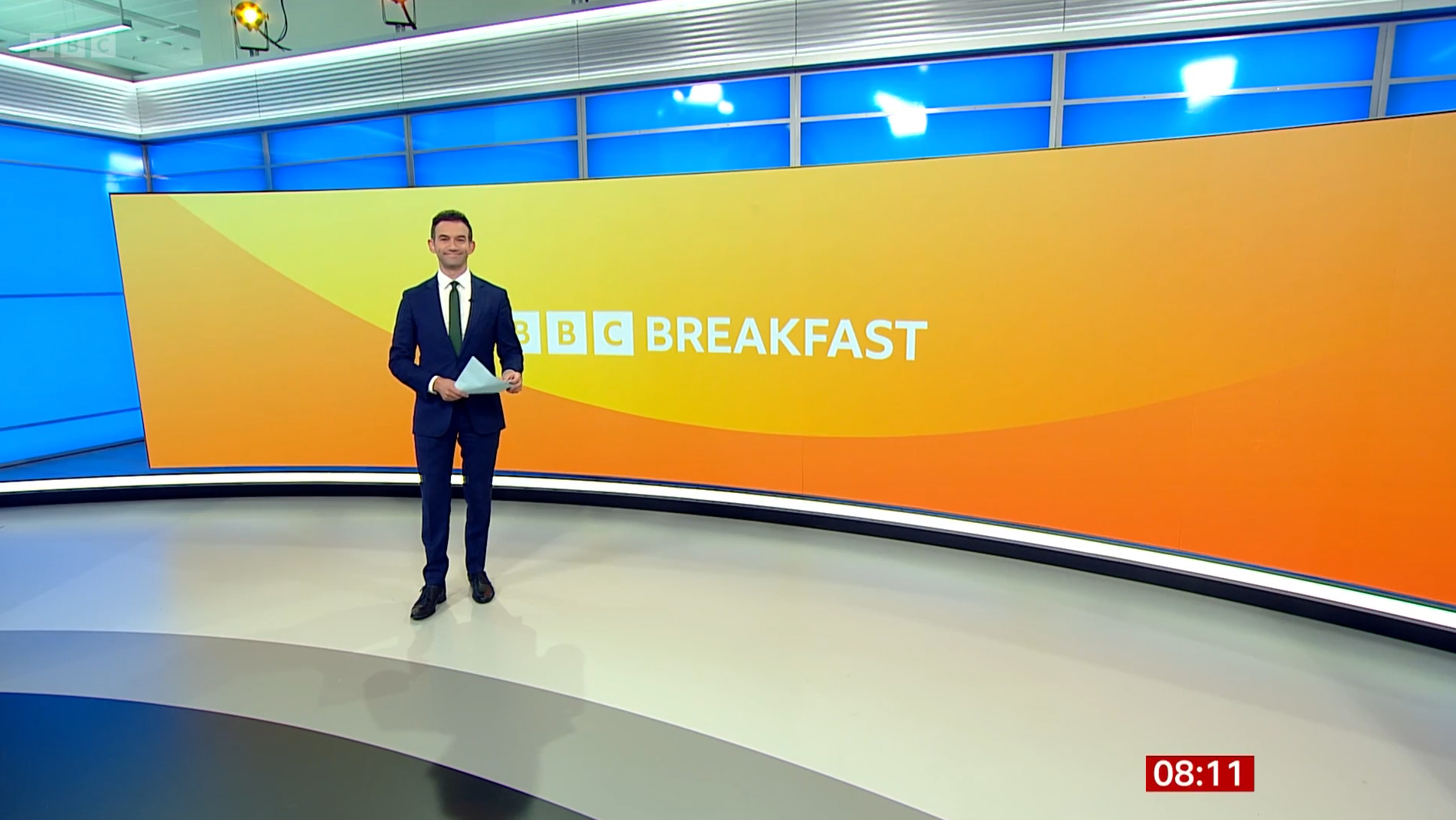

Tucked behind the angled wall is a curved LED video wall in front of backlit scenic panels. Although this appears to be inspired by the similarly-shaped installation in Studio B, it notably does not have a true catwalk — in the sense that it’s not raised off the floor.
To achieve a similar look, however, there is a band of medium-gray flooring just behind the angled tower that then gives way to off-white in front of the curved array.
The curved video wall area is primarily used for standups and weather during “Breakfast,” and the set’s layout includes the opportunity for cross-shooting into the space. Other shot blocking includes the angled LED tower as a background element, either behind a single presenter or in wide shots during in-studio interviews, tosses and debriefs.
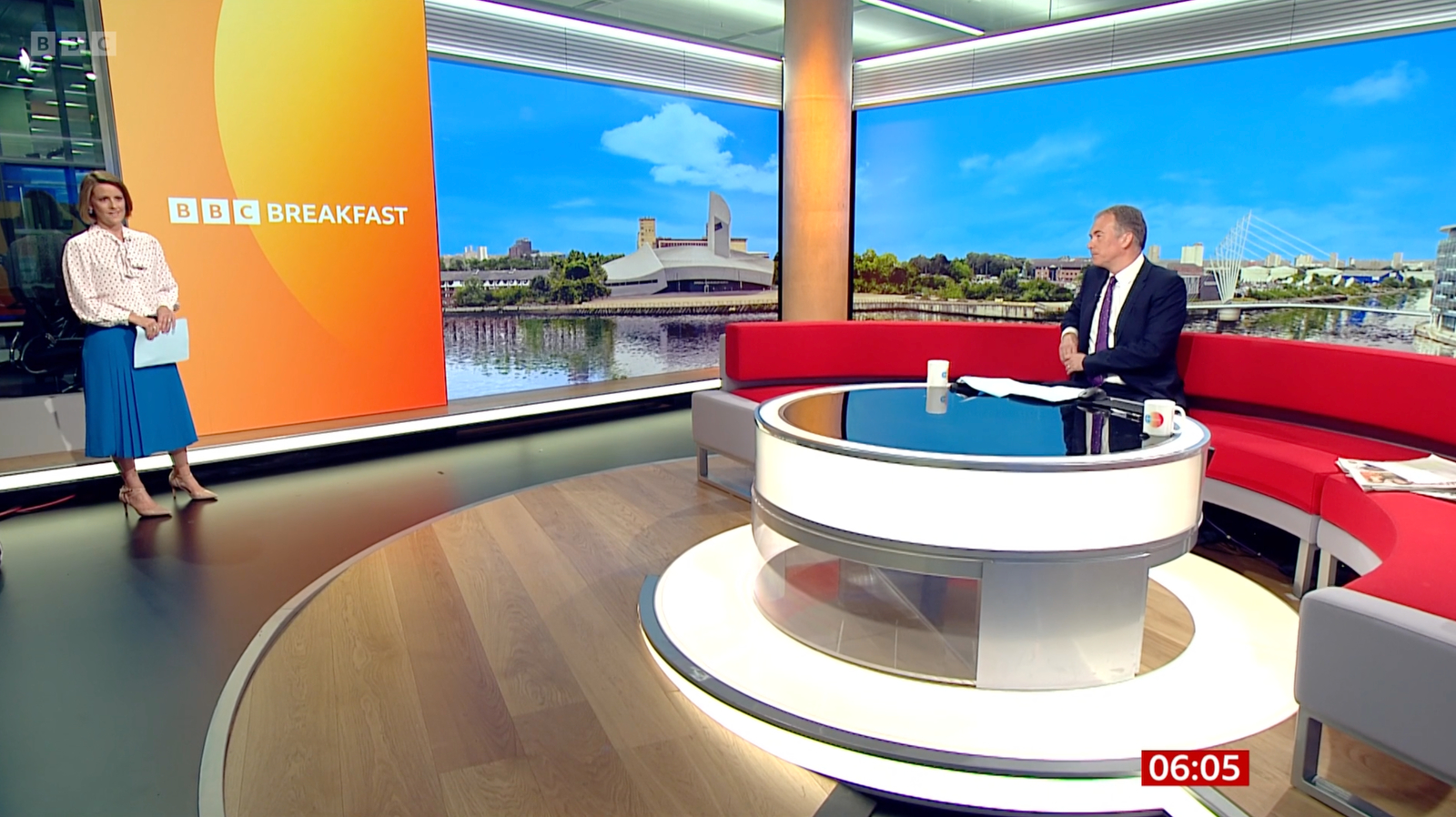

The opposite end of the studio is mainly dominated by two flat LED walls that intersect at a right angle at one of the building’s support columns. The larger of these two walls is used as the primary “Breakfast” background, while the second, smaller one shows up behind both anchor and guest one-shots and doubles as a shoot-off wall of sorts from the adjacent video tower.
Shots from both of the towers that help form the divider between the workspace and studio can include various views of the desks and monitors beyond. Video panels scattered around the work area can be fed matching graphics, and there is also the option to wash a wall with various colors thanks to integrated downlighting.
Unlike many of the other BBC facilities, the MediaCityUK studio does not rely on a track-based robotic camera system; instead, it uses fully robotic peds that can move around the space. This allows the broadcast to create smooth camera moves that are a hallmark of many productions on the BBC but with a bit more flexibility.
There is also a camera mounted high above the adjacent atrium-like work area that’s used primarily for bumps and gives viewers a glimpse into the studio through two glass panels. Augmented reality technology inserts ticker-like elements along the fascia that fronts the second floor balcony showcasing the date and time.
In addition, the reverse sides of the studio video towers are also outfitted with LED panels that appear in these shots.
Along with design from Jago Design and lead designer Sandra Fattore, Scenex provided fabrication with display tech from Anna Valley with studio robotics from Shotoku, prompts from Autoscript and cameras from Sony.
Updated graphics
“BBC Breakfast” also received a graphics update as part of the summer 2023 refresh.
The broadcast design still retains the notion of a sunrise against a horizon but with an updated color palette and approach to texture and accents.
Previously, the show used a mostly orange background with broad yellowish curve accents with glowing effects and a light burst. The word “Breakfast” was situated so the center of the line of text bumped very close to the arc, suggesting that the word was rising along with the sun.
The updated look combines red and orange along with blue hues.
Orange and red is not a new combination for the show, despite being what many consider to be clashing colors. The new backgrounds, however, use various gradients and shading effects to make the two colors merge more seamlessly.
Instead of the horizon-line arch, the new design uses oversized circle elements outlined with a gradient effect. This could be interpreted as either the earth or the sun — instead of a horizon line.
The semi-transparent nature of the circular elements’ shading has the advantage of being able to be placed behind the show name or other on-screen text or logos without as much concern about the exact placement. Instead of being a literal circle or curved line, the elements now feel airier, almost like bubbles.


In some applications, a bright blue is added into the mix, creating an eye-catching element that helps break up the field of warm shades. In the open, this element traverses the screen much like the sun does in the sky.
Despite the fact these shaded circles do, in fact, have an inner shadow, the design does move toward the flat design trend that the BBC and other broadcasters are embracing more and more.


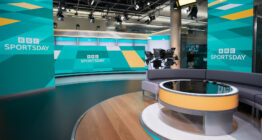
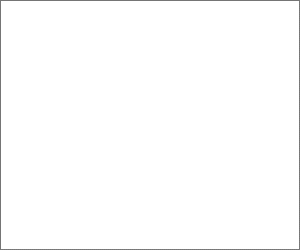

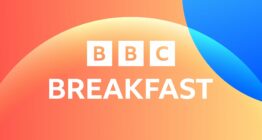


tags
Anna Valley, BBC, BBC Breakfast, BBC News, Estdale Scenex, jago design, mediacityuk, Sandra Fattore, simon jago, Video Walls
categories
Broadcast Design, Broadcast Industry News, Heroes, International Set Design, News Set Design, Set Design